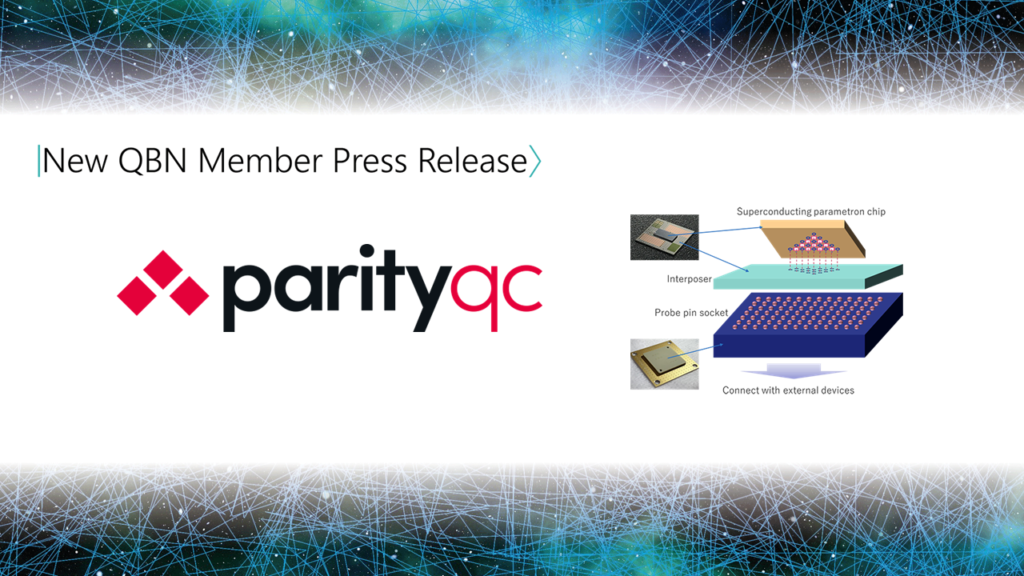Press release ParityQC, March 22nd 2022
NEC Corporation has developed the world’s first ParityQC architecture (LHZ scheme (1)) unit cell facilitating scaling up to a fully-connected architecture using superconducting parametron (2) quantum bits (qubits). NEC has succeeded in demonstrating quantum annealing operations using these qubits, which will enable high accuracy calculations. Through this achievement, NEC has made further progress toward the production of a quantum annealing machine (*3), which is a type of quantum computer.

Combinational optimization is important for finding solutions to complex social issues. It aims to find the optimal solution from an enormous set of potential choices. In 1999, NEC developed a superconducting qubit for use in gate-type quantum computers. Since then, NEC has applied the technology in the research and development of a quantum annealing machine using superconducting parametron qubits that can solve combinatorial optimization problems at high speed and with great accuracy.
NEC has developed a four qubit unit cell of the ParityQC (LHZ) architecture.
This enables scaling to multiple fully-connected logical qubits utilizing superconducting parametron and circuit coupling technology. NEC has achieved a world first by successfully solving small-scale combinatorial optimization problems via quantum annealing using this new technology. In another world first, NEC has also developed a three-dimensional structure technology that efficiently connects many ParityQC architecture unit cells arranged in a tile pattern with external devices.

By replicating the unit cell in a tile pattern, it is possible to easily create a structure where many qubits are logically connected to each other, whilst maintaining the features of the superconducting parametron that allow it to perform calculations with high accuracy. NEC has made progress toward the realization of a quantum annealing machine that can solve large-scale and complex combinatorial optimization problems at high speed.
NEC is working to develop a quantum annealing machine using superconducting parametrons as a project (*4) commissioned by the New Energy and Industrial Technology Development Organization (NEDO). NEC is currently conducting research and development to improve the integration of superconducting parametrons in a fully connected architecture, with the aim of realizing quantum annealing machines by 2023. NEC will use these results as building blocks to further accelerate the development of quantum computers.
| (*1) | ParityQC (LHZ) method: LHZ is an abbreviation for a technique proposed by Lechner, Hauke and Zoller. As the number of qubits increases, it becomes difficult in hardware to directly connect each qubit to each of the other qubits. To solve this problem, ParityQC proposed with LHZ a transformation that enables fully connected qubits to be obtained using quantum bits that are physically connected to only their nearest neighbours. A unit cell, composed of four qubits and a central coupling circuit connecting them can be replicated using a tilelike pattern. |
| (*2) | Superconducting parametron: A superconducting resonant circuit composed of Josephson junctions and capacitors which oscillates with different phases and can be used as a qubit. The lifetime of the qubit (which determines the upper limit of the time for which high speed operation is possible) is an order of magnitude longer than that of magnetic flux qubits. It is expected that calculations performed within a fixed time period will have improved accuracy. |
| (*3) | Quantum Annealing Machine: A computer that exploits the laws of quantum mechanics to search for the minimum energy state of a cost function. The minimum energy state corresponds to the solution of the combinatorial optimization problem. The smallest unit to be calculated is a qubit. As the number of qubits increases and the connectivity between the qubits increases, larger and more complex combinatorial optimization problems can be solved. |
| (*4) | Project for Innovative AI Chip and Next-Generation Computing Technology Development https://www.nedo.go.jp/english/activities/activities_ZZJP_100123.html |
About NEC Corporation
NEC Corporation has established itself as a leader in the integration of IT and network technologies while promoting the brand statement of “Orchestrating a brighter world.” NEC enables businesses and communities to adapt to rapid changes taking place in both society and the market as it provides for the social values of safety, security, fairness and efficiency to promote a more sustainable world where everyone has the chance to reach their full potential. For more information, visit https://www.nec.com.
About ParityQC
ParityQC is a spin-off from the University of Innsbruck and the Austrian Academy of Science and was founded by Prof. Dr. Wolfgang Lechner and Magdalena Hauser in January 2020. The company is based in Austria and Germany. In the context of the quantum computing industry, ParityQC has a unique positioning as a quantum architecture company, providing benefits for both hardware and software. The company offers blueprints for quantum computers to solve optimization problems, as well as the operating system ParityOS, which allows users to compile industry-relevant
problems in the most efficient way. For more information, visit parityqc.com.



